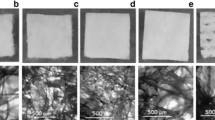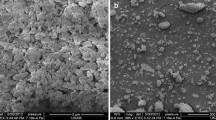Abstract
Background Zeolites have hemostatic properties used to stop bleeding in severe hemorrhage. Manufactured QuikClot® is an approved zeolite-based hemostatic agent for battlefield use. The exothermic reaction associated with QuikClot as loose granules or as granules packaged in a mesh bag has potential burn effects; this led to the development of a formulation of “cooler” non-exothermic QuikClot. The goal of this study was to compare the elevation of temperature of these formulations upon contact with blood. Methods Following full transection of the femoral vasculature, anesthetized Yorkshire pigs (n = 15) (28.8 ± 1.5 kg) were hemorrhaged for 2 min and treated with 100 g of bagged QuikClot (Advanced Clotting Sponge (ACS) (n = 4)) or a modified non-exothermic formulation (ACS+ (n = 11)). Vital signs and temperature at the dressing/tissue interface were continuously recorded for 3 h. Additional procedures were used to examine effects of different ratios of blood to zeolite on temperature elevation. Results Total post-treatment blood loss was comparable for ACS+_E and ACS_E groups (overall average: 18.6 ± 10.5% EBV). Temperature recorded at the dressing/tissue interface was significantly lower with ACS+ vs. ACS (40.3 ± 1.8 vs. 61.4 ± 10.7 °C, respectively, p < 0.01) and was 3.2 ± 2.6 °C higher than rectal temperature (38.0 ± 0.7 °C, p < 0.01). Survival at endpoint (7/11 vs. 4/4) and average survival time (134 ± 64 vs. 180 min) were greater for both ACS+ and ACS in comparison to Standard Dressing. The wound temperature with ACS was reduced with greater blood to product ratios and this pattern was paralleled with in vitro measurements. Conclusions The lower heat release with ACS+ compared to ACS was confirmed in an animal model and ACS+ had similar efficacy in arresting bleeding when compared to Standard Dressing.
Similar content being viewed by others
References
Acheson E. M., B. S. Kheirabadi, R. Deguzman, E. J. Dick, J. B. Holcomb 2005 Comparison of hemorrhage control agents applied to lethal extremity arterial hemorrhages in swine. J. Trauma 59, 865–874. doi:10.1097/01.ta.0000187655.63698.9f
Ahuja N., T. A. Ostomel, P. Rhee, G. D. Stucky, R. Conran, Z. Chen, G. A. Al-Mubarak, G. Velmahos, M. Demoya, H. B. Alam 2006 Testing of modified zeolite hemostatic dressings in a large animal model of lethal groin injury. J. Trauma 61, 1312–1320. doi:10.1097/01.ta.0000240597.42420.8f
Alam H. B., Z. Chen, A. Jaskille, R. Querol, E. Koustova, R. Inocencio, R. Conran, A. Seufert, N. Ariaban, K. Toruno, P. Rhee 2004 Application of a zeolite hemostatic agent achieves 100% survival in a lethal model of complex groin injury in swine. J. Trauma 56, 974–983. doi:10.1097/01.TA.0000127763.90890.31
Alam H. B., G. B. Uy, D. Miller, E. Koustova, T. Hancock, R. Inocencio, D. Anderson, O. Llorente, P. Rhee 2003 Comparative analysis of hemostatic agents in a swine model of lethal groin injury. J. Trauma 54, 1077–1082. doi:10.1097/01.TA.0000068258.99048.70
Arnaud F., T. Tomori, R. Saito, A. McKeague, W. K. Prusaczyk, R. M. McCarron 2007 Comparative efficacy of granular and bagged formulations of the hemostatic agent QuikClot. J. Trauma 63, 775–782
McManus J., T. Hurtado, A. Pusateri, K. J. Knoop 2007 A case series describing thermal injury resulting from zeolite use for hemorrhage control in combat operations. Prehosp. Emerg. Care 11, 67–71. doi:10.1080/10903120601021176
Ostomel, T. A., Q. Shi, P. K. Stoimenov, and G. D. Stucky. Metal oxide surface charge mediated hemostasis. Langmuir 23(22):1233–11238, 2007. doi:10.1021/la701281t.
Pusateri A. E., A. V. Delgado, E. J. Dick, R. S. Martinez, J. B. Holcomb, K. L. Ryan 2004 Application of a granular mineral-based hemostatic agent (QuikClot) to reduce blood loss after grade V liver injury in swine. J. Trauma 57, 555–562. doi:10.1097/01.TA.0000136155.97758.CD
Pusateri A. E., J. B. Holcomb, B. S. Kheirabadi, H. B. Alam, C. E. Wade, K. L. Ryan 2006 Making sense of the preclinical literature on advanced hemostatic products. J. Trauma 60, 674–682. doi:10.1097/01.ta.0000196672.47783.fd
Pusateri A. E., H. E. Modrow, R. A. Harris, J. B. Holcomb, J. R. Hess, R. H. Mosebar, T. J. Reid, J. H. Nelson, C. W. Goodwin, G. M. Fitzpatrick, A. T. McManus, D. T. Zolock, J. L. Sondeen, R. L. Cornum, R. S. Martinez (2003) Advanced hemostatic dressing development program: animal model selection criteria and results of a study of nine hemostatic dressings in a model of severe large venous hemorrhage and hepatic injury in swine. J. Trauma 55, 518–526. doi:10.1097/01.TA.0000075336.92129.27
Rhee P., C. Brown, M. Martin, A. Salim, D. Plurad, D. Green, L. Chambers, D. Demetriades, G. Velmahos, H. Alam 2008 QuikClot use in trauma for hemorrhage control: case series of 103 documented uses. J. Trauma 64, 1093–1099. doi:10.1097/TA.0b013e31812f6dbc
Wright J. K., J. Kalns, E. A. Wolf, F. Traweek, S. Schwarz, C. K. Loeffler, W. Snyder, L. D. Yantis, J. Eggers 2004 Thermal injury resulting from application of a granular mineral hemostatic agent. J. Trauma 57, 224–230. doi:10.1097/01.TA.0000105916.30158.06
Acknowledgments
Test materials were provided by Z-Medica, Wallingford, CT (ACS, ACS+); and H and H Associates, Inc., Bena, VA (standard dressing). The authors wish to thank M. Hammett, D. Fasipe, B. Esperat and N. Carballo for technical assistance. Z-Medica, Wallingford, CT for providing QuikClot® products, MARCORSYSCOM for funding this study.
Author information
Authors and Affiliations
Corresponding author
Additional information
The views expressed in this article are those of the author and do not necessarily reflect the official policy or position of the Department of the Navy, Department of Defense, nor the U.S. Government.
Authors are military service member or employees of the U.S. Government. This work was prepared as part of official duties. Title 17 U.S.C. §105 provides that ‘Copyright protection under this title is not available for any work of the United States Government.’ Title 17 U.S.C. §101 defines a U.S. Government work as a work prepared by a military service member or employee of the U.S. Government as part of that person’s official duties.
Rights and permissions
About this article
Cite this article
Arnaud, F., Tomori, T., Carr, W. et al. Exothermic Reaction in Zeolite Hemostatic Dressings: QuikClot ACS and ACS+® . Ann Biomed Eng 36, 1708–1713 (2008). https://doi.org/10.1007/s10439-008-9543-7
Received:
Accepted:
Published:
Issue Date:
DOI: https://doi.org/10.1007/s10439-008-9543-7




